Climate Projections for Pinot Noir Ripening Potential in the Fort Ross-Seaview, Los Carneros, Petaluma Gap, and Russian River Valley American Viticultural Areas
Abstract
1. Introduction
2. Materials and Methods
2.1. Study Area
2.2. Data
2.2.1. MACA CMIP5
2.2.2. MACA CMIP5 Training Dataset: Metdata
2.2.3. Topography Weather Dataset
2.3. GST Climate Index
2.4. GSR Phenology Model
Fit and Extrapolation of Pinot Noir Specific GSR Sugar Concentration and Thermal Summation Values
2.5. MACA CMIP5 Ensemble Subset Selection
3. Results and Discussion
3.1. MACA CMIP5 Ensemble Subset Selection
3.2. GST Climate Index
Spatiotemporal Distribution
3.3. GSR Phenology Model
3.3.1. Fit and Extrapolation of Pinot Noir Specific GSR Sugar Concentration and Thermal Summation Values
3.3.2. Spatiotemporal Distribution
3.3.3. Comparison of Reported Harvest Dates with GSR Model Calculations
3.4. GSR–GST Relationships
4. Conclusions
Supplementary Materials
Author Contributions
Funding
Data Availability Statement
Acknowledgments
Conflicts of Interest
References
- Malheiro, A.C.; Campos, R.; Fraga, H.; Eiras-Dias, J.; Silvestre, J.; Santos, J.A. Winegrape phenology and temperature relationships in the Lisbon wine region, Portugal. J. Int. Des. Sci. Vigne Vin 2013, 47, 287–299. [Google Scholar] [CrossRef]
- Cameron, W.; Petrie, P.R.; Barlow, E.; Howell, K.; Jarvis, C.; Fuentes, S. A comparison of the effect of temperature on grapevine phenology between vineyards. OENO One 2021, 55, 301–320. [Google Scholar] [CrossRef]
- Koufos, G.C.; Mavromatis, T.; Koundouras, S.; Jones, G.V. Adaptive capacity of winegrape varieties cultivated in Greece to climate change: Current trends and future projections. OENO One 2020, 4, 1201–1219. [Google Scholar] [CrossRef]
- Jarvis, C.; Barlow, E.; Darbyshire, R.; Eckard, R.; Goodwin, I. Relationship between viticultural climatic indices and grape maturity in Australia. Int. J. Biometeorol. 2017, 61, 1849–1862. [Google Scholar] [CrossRef] [PubMed]
- Bock, A.; Sparks, T.; Estrella, N.; Menzel, A. Changes in the phenology and composition of wine from Franconia, Germany. Clim. Res. 2011, 50, 69–81. [Google Scholar] [CrossRef]
- Parker, A.; de Cortázar-Atauri, I.; van Leeuwen, C.; Chuine, I. General phenological model to characterise the timing of flowering and veraison of Vitis vinifera L. Aust. J. Grape Wine Res. 2011, 17, 206–216. [Google Scholar] [CrossRef]
- Tomasi, D.; Jones, G.V.; Giust, M.; Lovat, L.; Gaiotti, F. Grapevine Phenology and Climate Change: Relationships and Trends in the Veneto Region of Italy for 1964–2009. Am. J. Enol. Vitic. 2011, 62, 329–339. [Google Scholar] [CrossRef]
- Schultz, H.R.; Jones, G.V. Climate Induced Historic and Future Changes in Viticulture. J. Wine Res. 2010, 21, 137–145. [Google Scholar] [CrossRef]
- Jones, G.V. Climate and terroir: Impacts of climate variability and change on wine. In Fine Wine and Terroir-The Geoscience Perspective, Proceedings of the Geological Society of American Annual Meeting, Seattle, WA, USA, 2 November 2003; Macqueen, R.W., Meinert, L.D., Eds.; Geoscience Canada Reprint Series Number 9; Geological Association of Canada: St. John’s, NL, Canada, 2006; pp. 1–14. [Google Scholar]
- Jones, G.V.; White, M.A.; Cooper, O.R.; Storchmann, K. Climate change and global wine quality. Clim. Change 2005, 73, 319–343. [Google Scholar] [CrossRef]
- Jones, G.V. Climate change and the global wine industry. In Proceedings of the Thirteenth Australian Wine Industry Technical Conference, Adelaide, Australia, 28 July–2 August 2007. [Google Scholar]
- Jackson, D.I.; Lombard, P.B. Environmental and Management Practices Affecting Grape Composition and Wine Quality—A Review. Am. J. Enol. Vitic. 1993, 44, 409–430. Available online: https://www.ajevonline.org/content/44/4/409 (accessed on 3 October 2022). [CrossRef]
- van Leeuwen, C.; Destrac-Irvine, A.; Dubernet, M.; Duchêne, E.; Gowdy, M.; Marguerit, E.; Pieri, P.; Parker, A.; de Rességuier, L.; Ollat, N. An Update on the Impact of Climate Change in Viticulture and Potential Adaptations. Agronomy 2019, 9, 514. [Google Scholar] [CrossRef]
- Kliewer, W.M. Berry Composition of Vitis vinifera Cultivars as Influenced by Photo- and Nycto-Temperatures during Maturation. J. Amer. Soc. Hort Sci. 1973, 98, 153–159. [Google Scholar] [CrossRef]
- Pons, A.; Allamy, L.; Schüttler, A.; Rauhut, D.; Thibon, C.; Darriet, P. What is the expected impact of climate change on wine aroma compounds and their precursors in grape? OENO One 2017, 51, 141–146. [Google Scholar] [CrossRef]
- Kliewer, W.M. Effect of Day Temperature and Light Intensity on Coloration of Vitis vinifera L. Grapes. J. Amer. Soc. Hort. Sci. 1970, 95, 693–697. [Google Scholar] [CrossRef]
- Kliewer, W.M.; Torres, R.E. Effect of controlled day and night temperatures on grape coloration. J. Enol. Viticult. 1972, 23, 71–77. [Google Scholar]
- Deloire, A.; Vaudour, E.; Carey, V.A.; Bonnardot, V.; van Leeuwen, C. Grapevine responses to terroir: A global approach. OENO One 2005, 39, 149–162. [Google Scholar] [CrossRef]
- van Leeuwen, C.; Seguin, G. The concept of terroir in viticulture. J. Wine Res. 2006, 17, 1–10. [Google Scholar] [CrossRef]
- van Leeuwen, C. Terroir: The effect of the physical environment on vine growth, grape ripening and wine sensory attributes. In Managing Wine Quality; Reynolds, A.G., Ed.; Woodhead Publishing Series in Food Science, Technology and Nutrition; Woodhead Publishing Limited: Cambridge, UK, 2010; pp. 273–315. [Google Scholar] [CrossRef]
- Rienth, M.; Lamy, F.; Schoenenberger, P.; Noll, D.; Lorenzini, F.; Viret, O.; Zufferey, V. A vine physiology-based terroir study in the AOC-Lavaux region in Switzerland: This article is published in cooperation with the XIIIth International Terroir Congress November 17-18 2020, Adelaide, Australia. Guest editors: Cassandra Collins and Roberta De Bei. OENO One 2020, 54, 863–880. [Google Scholar] [CrossRef]
- Cabré, F.; Nuñez, M. Impacts of climate change on viticulture in Argentina. Reg Env. Change 2020, 20, 12. [Google Scholar] [CrossRef]
- Trbic, G.; Djurdjevic, V.i.; Mandic, M.V.; Ivanisevic, M.; Cupac, R.; Bajic, D.; Zahirovic, E.; Filipovic, D.; Dekic, R.; Popov, T.; et al. The impact of climate change on grapevines in Bosnia and Herzegovina. Euro-Mediterr. J. Environ. Integr. 2021, 6, 4. [Google Scholar] [CrossRef]
- Cardell, M.F.; Amengual, A.; Romero, R. Future effects of climate change on the suitability of wine grape production across Europe. Reg. Environ. Change 2020, 19, 2299–2310. [Google Scholar] [CrossRef]
- Teslic, N.; Vujadinovic, M.; Ruml, M.; Ricci, A.; Vukovic, A.; Parpinello, G.P.; Versari, A. Future climatic suitability of the Emilia-Romagna (Italy) region for grape production. Reg. Environ. Change 2019, 19, 599–614. [Google Scholar] [CrossRef]
- Dal Monte, G.; Labagnara, T.; Cirigliano, P. Agroclimatic evaluation of Val d’Agri (Basilicata, Italy) suitability for grapevine quality: The example of PDO “Terre dell’Alta Val d’Agri” area in a climate change scenario. Ital. J. Agrometeorol. 2019, 3, 3–12. [Google Scholar] [CrossRef]
- Santos, M.; Fonseca, A.; Fraga, H.; Jones, G.V.; Santos, J.A. Bioclimatic conditions of the Portuguese wine denominations of origin under changing climates. Int. J. Climatol. 2019, 40, 927–941. [Google Scholar] [CrossRef]
- Blanco-Ward, D.; Ribeiro, A.; Barreales, D.; Castro, J.; Verdial, J.; Feliciano, M.; Viceto, C.; Rocha, A.; Carlos, C.; Silveira, C.; et al. Climate change potential effects on grapevine bioclimatic indices: A case study for the Portuguese demarcated Douro Region (Portugal). BIO Web Conf. 2019, 12, 01013. [Google Scholar] [CrossRef]
- Irimia, L.M.; Patriche, C.V.; LeRoux, R.; Quénol, H.; Tissot, C.; Sfîcă, L. Projections of Climate Suitability for Wine Production for the Cotnari Wine Region (Romania). Present Environ. Sustain. Dev. 2019, 13, 5–18. [Google Scholar] [CrossRef]
- Sirnik, I. Spatial-Temporal Analysis of Climate Change Impact on Viticultural Regions Valencia DO and Goriška Brda. Ph.D. Thesis, Universitat Politécnica de Valencia and Université Rennes 2, Universitat Politécnica de Valencia Repository, Valencia, Spain, 2019. Available online: https://riunet.upv.es/bitstream/handle/10251/131695/Sirnik%20-%20Spatial-temporal%20analysis%20of%20climate%20change%20impact%20on%20viticultural%20regions%20Valencia%20DO%20a…pdf?sequence=1 (accessed on 16 February 2020).
- Sánchez, Y.; Martínez-Graña, A.M.; Santos-Francés, F.; Yenes, M. Index for the calculation of future wine areas according to climate change application to the protected designation of origin “Sierra de Salamanca” (Spain). Ecol. Indic. 2019, 107, 105646. [Google Scholar] [CrossRef]
- Skahill, B.; Berenguer, B.; Stoll, M. Temperature-based Climate Projections of Pinot noir Suitability in the Willamette Valley American Viticultural Area. OENO One 2022, 56, 209–225. [Google Scholar] [CrossRef]
- Pierce, D.W.; Cayan, D.R.; Thrasher, B.L. Statistical Downscaling Using Localized Constructed Analogs (LOCA). J. Hydrometeorol. 2015, 15, 2558–2585. [Google Scholar] [CrossRef]
- Pierce, D.W.; Cayan, D.R.; Maurer, E.P.; Abatzoglou, J.T.; Hegewisch, K.C. Improved bias correction techniques for hydrological simulations of climate change. J. Hydrometeorol. 2015, 16, 2421–2442. [Google Scholar] [CrossRef]
- Parker, A.K.; García de Cortázar-Atauri, I.; Gény, L.; Spring, J.-L.; Destrac, A.; Schultz, H.; Molitor, D.; Lacombe, T.; Graça, A.; Monamy, C.; et al. Temperature-based grapevine sugar ripeness modelling for a wide range of Vitis vinifera L. cultivars. Agric. For. Meteorol. 2020, 285–286, 107902. [Google Scholar] [CrossRef]
- van Leeuwen, C.; Schultz, H.R.; Garcia de Cortazar-Atauri, I.; Duchêne, E.; Ollat, N.; Pieri, P.; Bois, B.; Goutouly, J.P.; Quénol, H.; Touzard, J.M.; et al. Why climate change will not dramatically decrease viticultural suitability in main wine-producing areas by 2050. Proc. Natl. Acad. Sci. USA 2013, 110, E3051–E3052. [Google Scholar] [CrossRef] [PubMed]
- Werner, A.T.; Schnorbus, M.A.; Shrestha, R.R.; Cannon, A.J.; Zwiers, F.W.; Dayon, G.; Anslow, F. A long-term, temporally consistent, gridded daily meteorological dataset for northwestern North America. Sci. Data 2019, 6, 180299. [Google Scholar] [CrossRef] [PubMed]
- Jones, G.V.; Webb, L.B. Climate Change, Viticulture, and Wine: Challenges and Opportunities. J. Wine Res. 2010, 21, 103–106. [Google Scholar] [CrossRef]
- Hall, A.; Jones, G.V. Effect of potential atmospheric warming on temperature based indices describing Australian winegrape growing conditions. Aust. J. Grape Wine Res. 2009, 15, 97–119. [Google Scholar] [CrossRef]
- Blank, M.; Hofmann, M.; Stoll, M. Seasonal differences in Vitis vinifera L. cv. Pinot noir fruit and wine quality in relation to climate. OENO One 2019, 53, 189–203. [Google Scholar] [CrossRef]
- Abatzoglou, J.T.; Brown, T.J. A comparison of statistical downscaling methods suited for wildfire applications. Int. J. Climatol. 2012, 32, 772–780. [Google Scholar] [CrossRef]
- MACA Data Portal. Available online: https://climate.northwestknowledge.net/MACA/data_portal.php (accessed on 6 January 2023).
- Livneh, B.; Rosenberg, E.A.; Lin, C.; Nijissen, B.; Mishra, V.; Andreadis, K.M.; Maurer, E.P.; Lettenmaier, D.P. A long-term hydrologically based dataset of land surface fluxes and states for the conterminous United States: Updates and extensions. J. Clim. 2013, 26, 9384–9392. [Google Scholar] [CrossRef]
- Walton, D.; Hall, A. An Assessment of High-Resolution Gridded Temperature Datasets over California. J. Clim. 2018, 31, 3789–3810. [Google Scholar] [CrossRef]
- Abatzoglou, J.T. Development of gridded surface meteorological data for ecological applications and modelling. Int. J. Climatol. 2013, 33, 121–131. [Google Scholar] [CrossRef]
- Daly, C.; Halbleib, M.; Smith, J.I.; Gibson, W.P.; Doggett, M.K.; Taylor, G.H.; Curtis, J.; Pasteris, P.P. Physiographically sensitive mapping of climatological temperature and precipitation across the conterminous United States. Int. J. Climatol. 2008, 28, 2031–2064. [Google Scholar] [CrossRef]
- Zou, H.; Hastie, T. Regularization and Variable Selection via the Elastic Net. J. R. Stat. Soc. B 2005, 67, 301–320. [Google Scholar] [CrossRef]
- Skahill, B.; Berenguer, B.; Stoll, M. Ensembles for Viticulture Climate Classifications of the Willamette Valley Wine Region. Climate 2021, 9, 140. [Google Scholar] [CrossRef]
- Herger, N.; Abramowitz, G.; Knutti, R.; Angélil, O.; Lehmann, K.; Sanderson, B.M. Selecting a climate model subset to optimise key ensemble properties. Earth Syst. Dynam. 2018, 9, 135–151. [Google Scholar] [CrossRef]
- Giorgi, F.; Mearns, L.O. Calculation of Average, Uncertainty Range, and Reliability of Regional Climate Changes from AOGCM Simulations via the “Reliability Ensemble Averaging” (REA) Method. J. Clim. 2002, 15, 1141–1158. [Google Scholar] [CrossRef]
- Treasury Decision TTB-98, Establishment of the Fort Ross-Seaview Viticultural Area, 76 Fed. Reg. 77684. 27 CFR Part 9. 13 January 2012. Available online: https://www.regulations.gov/docket/TTB-2011-0004/document (accessed on 23 November 2022).
- Treasury Decision ATF-142, Establishment of Los Carneros Viticultural Area, 48 Fed. Reg. 37365. 27 CFR Part 9. 19 September 1983. Available online: https://www.ttb.gov/images/pdfs/Los_Carneros_final_rule.pdf (accessed on 23 November 2022).
- Treasury Decision TTB-149, Establishment of the Petaluma Gap Viticultural Area and Modification of the North Coast Viticultural Area, 82 Fed. Reg. 57659. 27 CFR Part 9. 8 January 2018. Available online: https://www.regulations.gov/docket/TTB-2016-0009/document (accessed on 23 November 2022).
- First Harvest for New Petaluma Gap AVA. Available online: https://www.petaluma360.com/article/news/first-harvest-for-new-petaluma-gap-ava/ (accessed on 7 January 2023).
- Treasury Decision ATF-159, Russian River Valley Viticultural Area, 48 Fed. Reg. 48812. 27 CFR Part 9. 21 November 1983. Available online: https://www.ttb.gov/images/pdfs/Russian_River_Valley_final_rule.pdf (accessed on 23 November 2022).
- Treasury Decision TTB-7, Expansion of the Russian River Valley Viticultural Area (2002R-421P), 68 Fed. Reg. 67367. 27 CFR Part 9. 2 February 2004. Available online: https://www.ttb.gov/images/pdfs/rrd/ttb_td07.pdf (accessed on 23 November 2022).
- Treasury Decision TTB-32, Expansion of the Russian River Valley Viticultural Area (2003R-144T), 70 Fed. Reg. 53297. 27 CFR Part 9. 11 October 2005. Available online: https://www.govinfo.gov/content/pkg/FR-2005-09-08/pdf/05-17758.pdf (accessed on 23 November 2022).
- Treasury Decision TTB-97, Expansions of the Russian River Valley and Northern Sonoma Viticultural Areas (2003R-144T), 76 Fed. Reg. 70866. 27 CFR Part 9. 16 December 2011. Available online: https://www.regulations.gov/docket/TTB-2008-0009/document (accessed on 23 November 2022).
- Thomson, A.M.; Calvin, K.V.; Smith, S.J.; Kyle, G.P.; Volke, A.; Patel, P.; Delgado-Arias, S.; Bond-Lamberty, B.; Wise, M.A.; Clarke, L.E.; et al. RCP4.5: A pathway for stabilization of radiative forcing by 2100. Clim. Change 2011, 109, 77–94. [Google Scholar] [CrossRef]
- Riahi, K.; Rao, S.; Krey, V.; Cho, C.; Chirkov, V.; Fischer, G.; Kindermann, G.; Nakicenovic, N.; Rafaj, P. RCP 8.5—A scenario of comparatively high greenhouse gas emissions. Clim. Change 2011, 109, 33–57. [Google Scholar] [CrossRef]
- van Vuuren, D.P.; Stehfest, E.; den Elzen, M.G.J.; Kram, T.; van Vliet, J.; Deetman, S.; Isaac, M.; Goldewijk, K.K.; Hof, A.; Beltran, A.M.; et al. RCP2.6: Exploring the possibility to keep global mean temperature increase below 2 °C. Clim. Chang。 2011, 109, 95. [Google Scholar] [CrossRef]
- Xia, Y.; Mitchell, K.; Ek, M.; Sheffield, J.; Cosgrove, B.; Wood, E.; Luo, L.; Alonge, C.; Wei, H.; Meng, J.; et al. Continental-scale water and energy flux analysis and validation for the North American Land Data Assimilation System project phase 2 (NLDAS-2): 1. Intercomparison and application of model products. J. Geophys. Res. 2012, 117, D03109. [Google Scholar] [CrossRef]
- Oyler, J.W.; Ballantyne, A.; Jencso, K.; Sweet, M.; Running, S.W. Creating a topoclimatic daily air temperature dataset for the conterminous United States using homogenized station data and remotely sensed land skin temperature. Int. J. Climatol. 2015, 35, 2258–2279. [Google Scholar] [CrossRef]
- Cowey, G. Predicting alcohol levels. Aust. N. Z. Grapegrow. Winemak. 2016, 626, 68. [Google Scholar]
- Storn, R.; Price, K. Differential Evolution–A Simple and Efficient Heuristic for Global Optimization over Continuous Spaces. J. Glob. Optim. 1997, 11, 341–359. [Google Scholar] [CrossRef]
- Nash, J.E.; Sutcliffe, J.V. River flow forecasting through conceptual models part I—A discussion of principles. J. Hydrol. 1970, 10, 282–290. [Google Scholar] [CrossRef]
- Gupta, H.V.; Kling, H.; Yilmaz, K.K.; Martinez, G.F. Decomposition of the mean squared error and NSE performance criteria: Implications for improving hydrological modelling. J. Hydrol. 2009, 377, 80–91. [Google Scholar] [CrossRef]
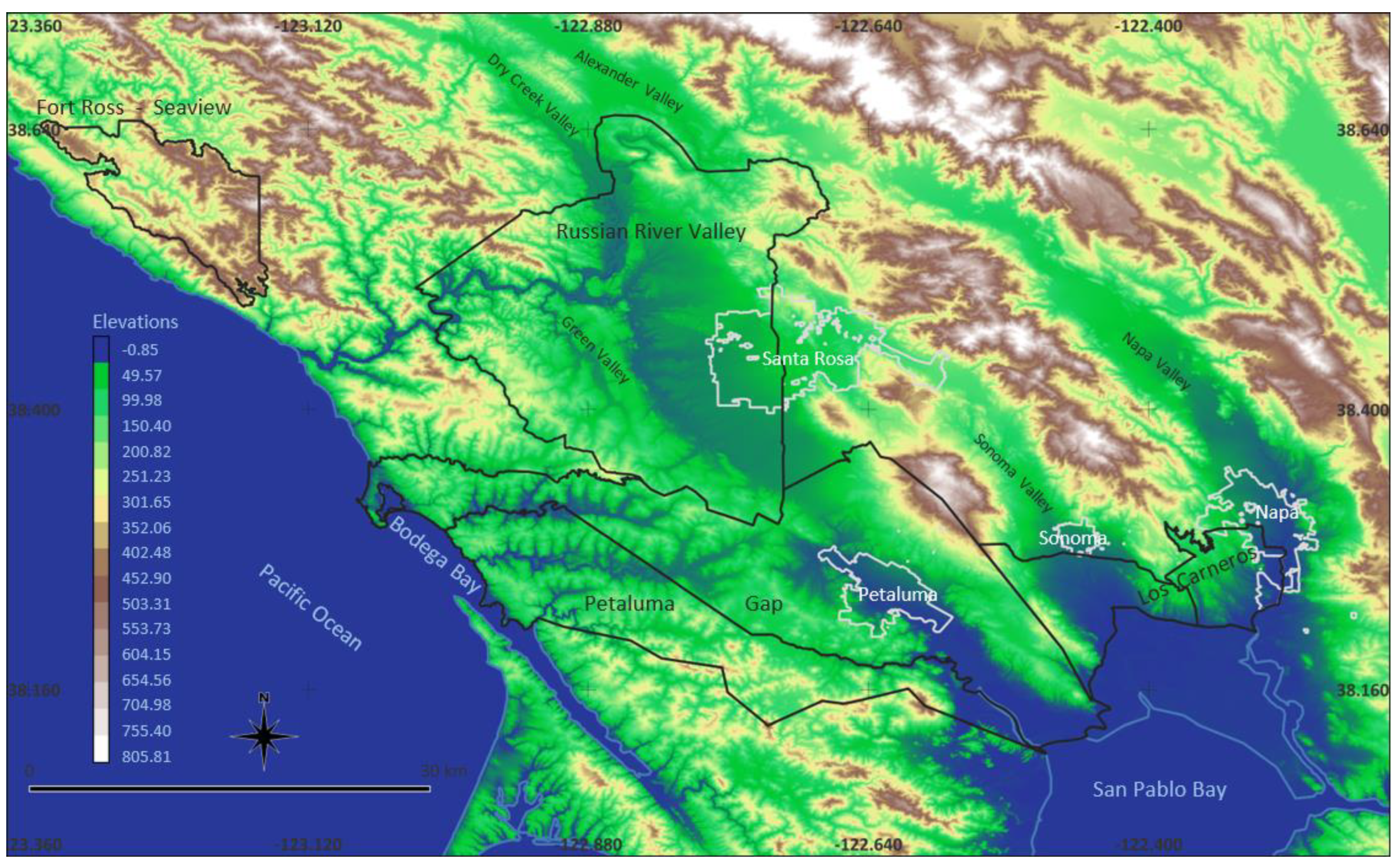
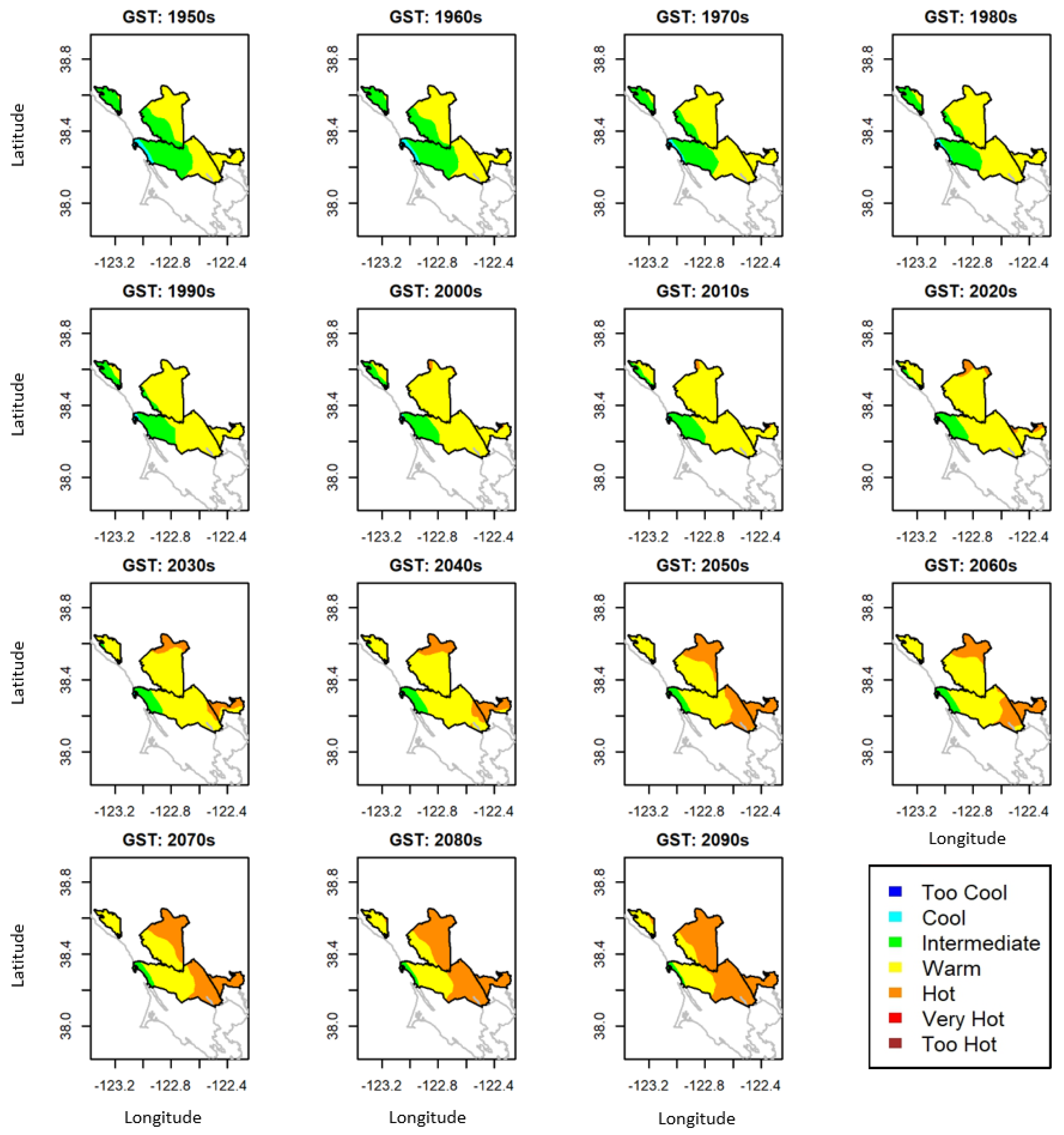
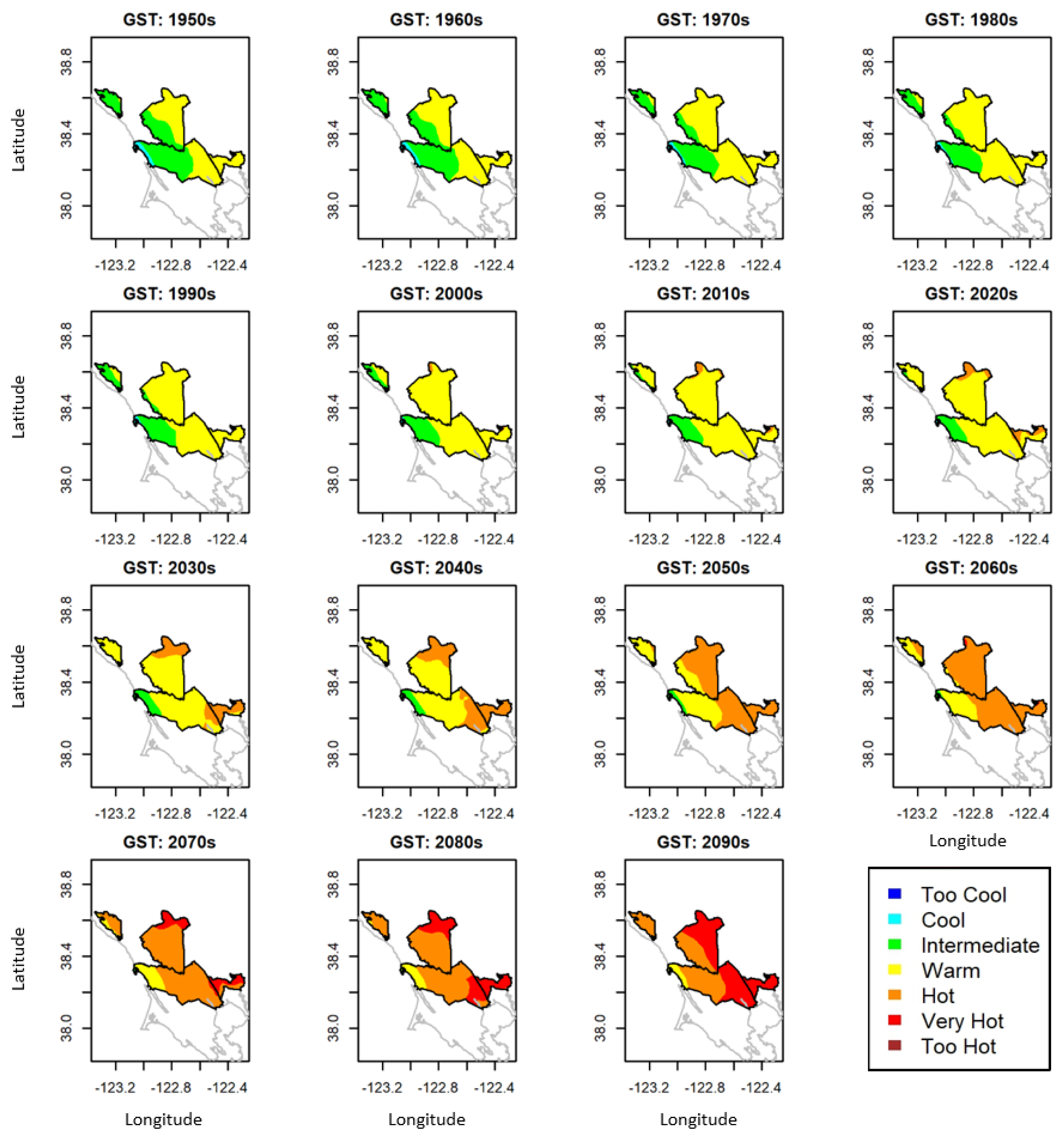
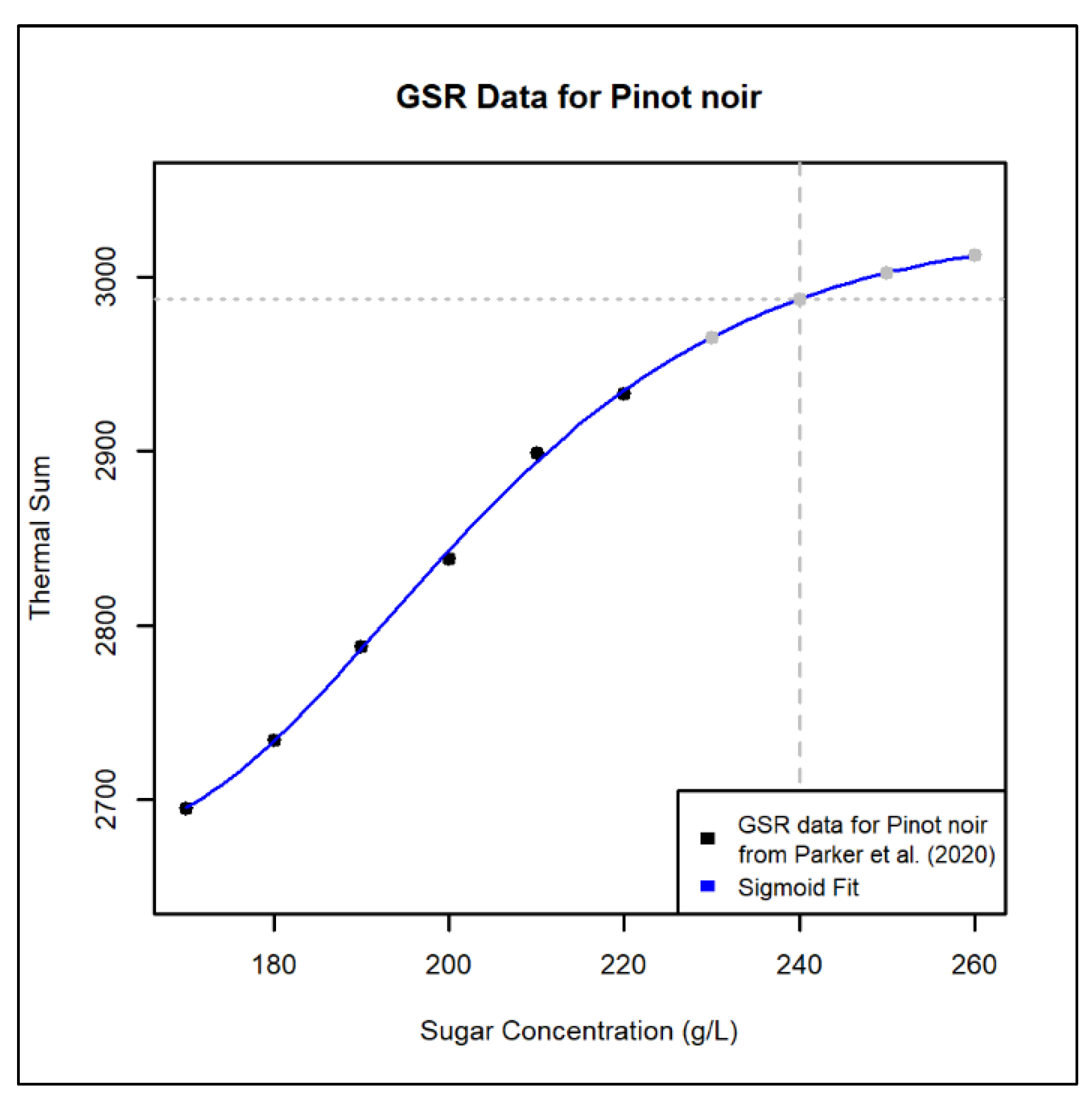

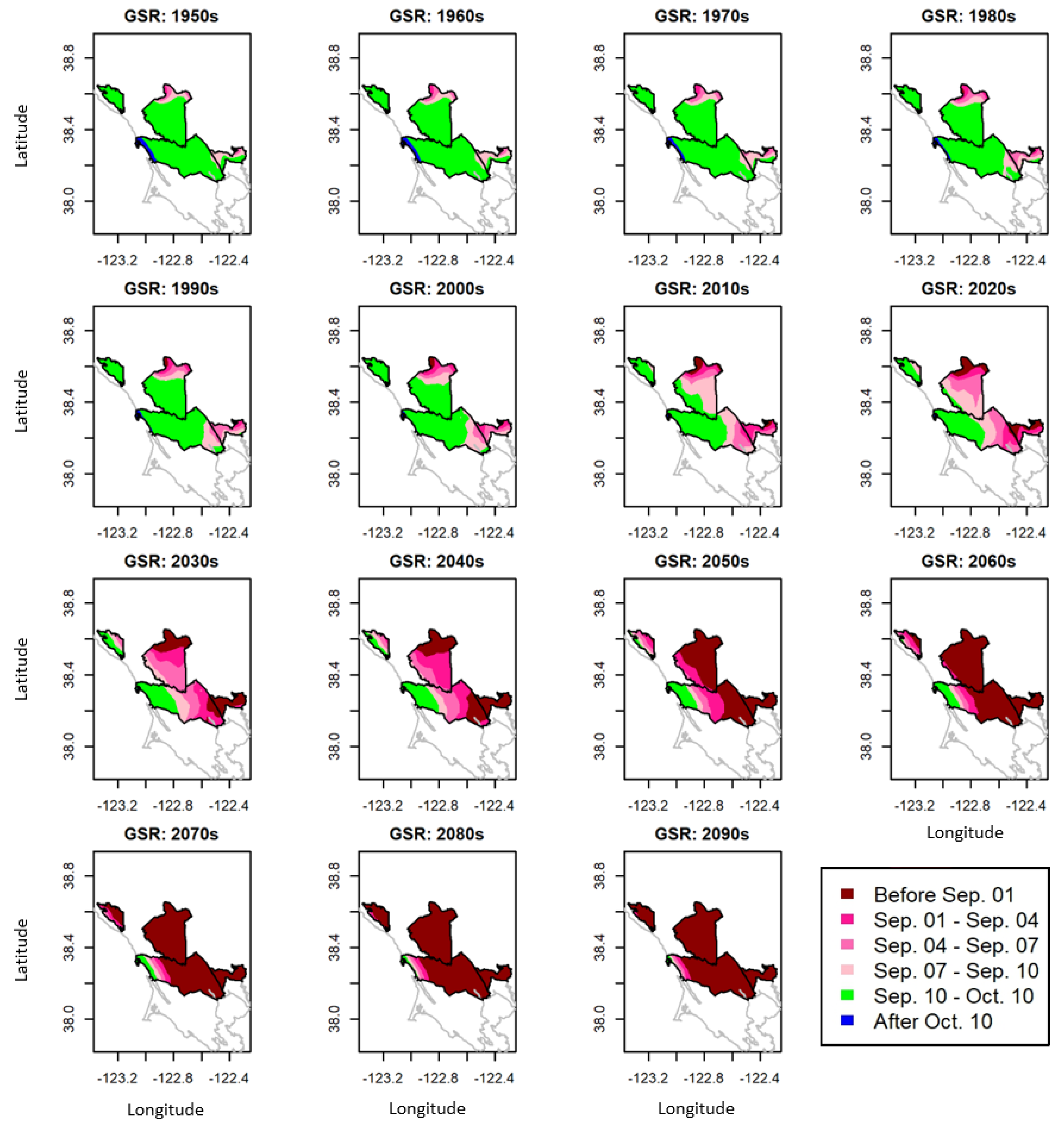
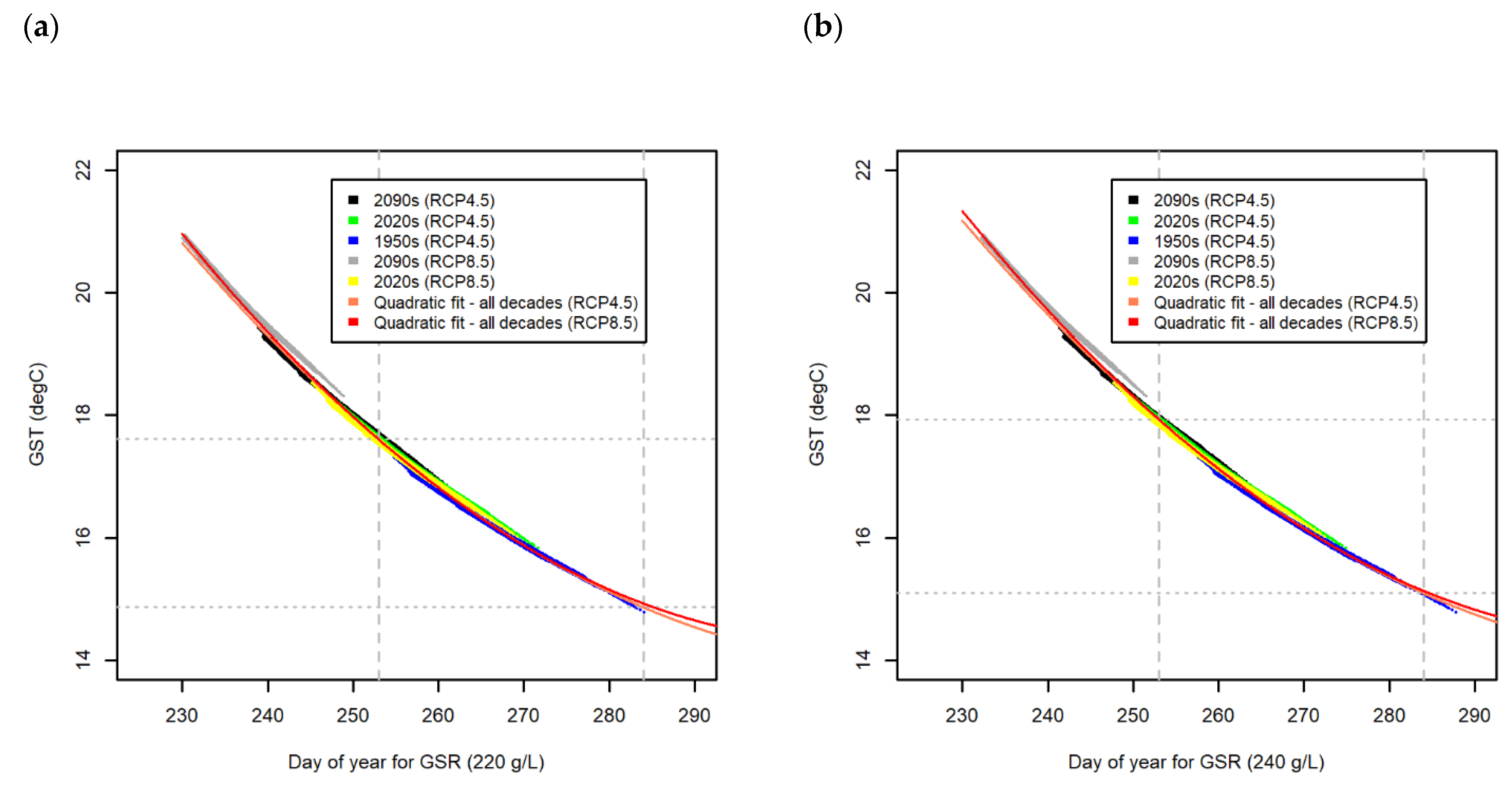

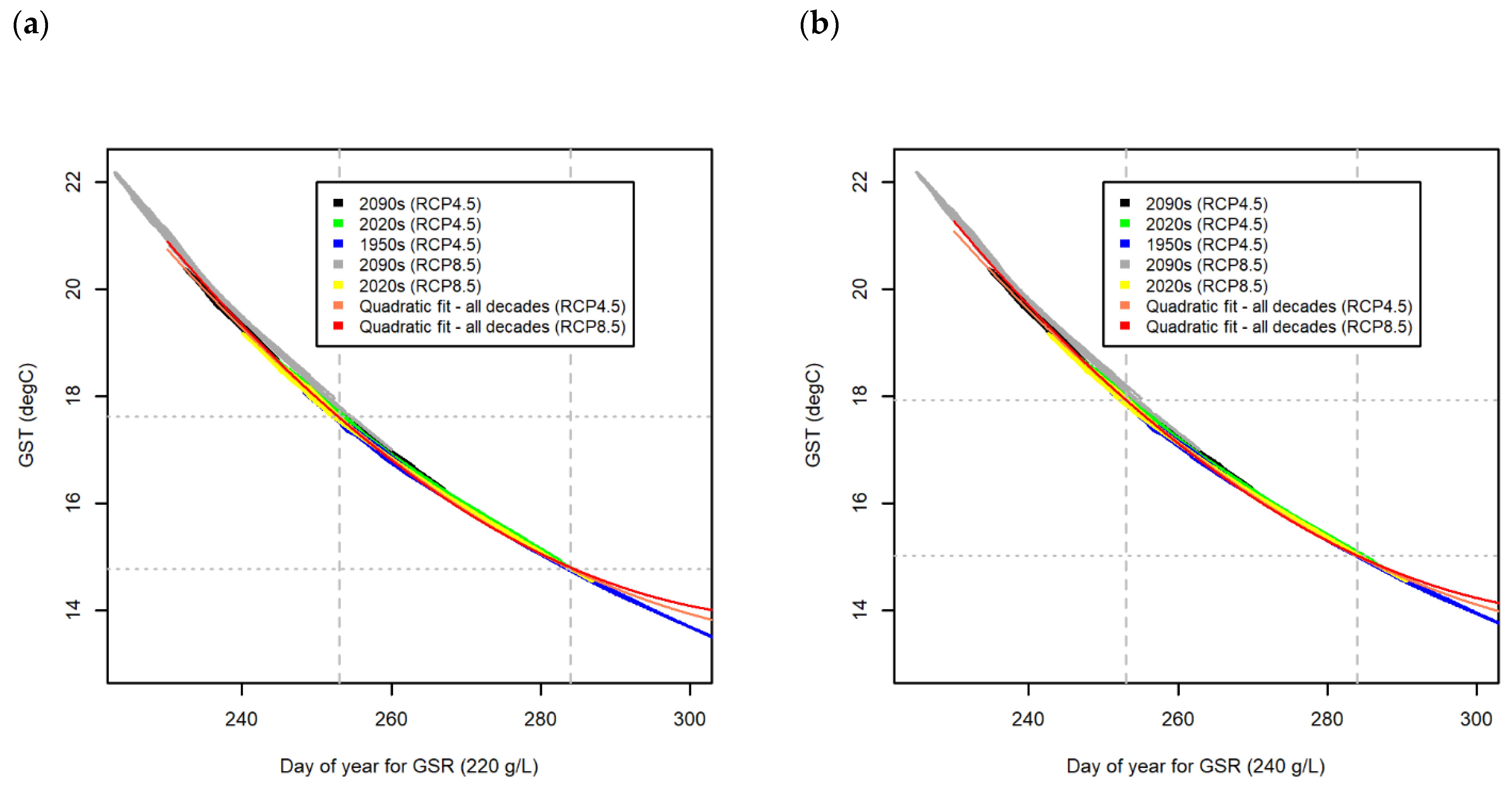
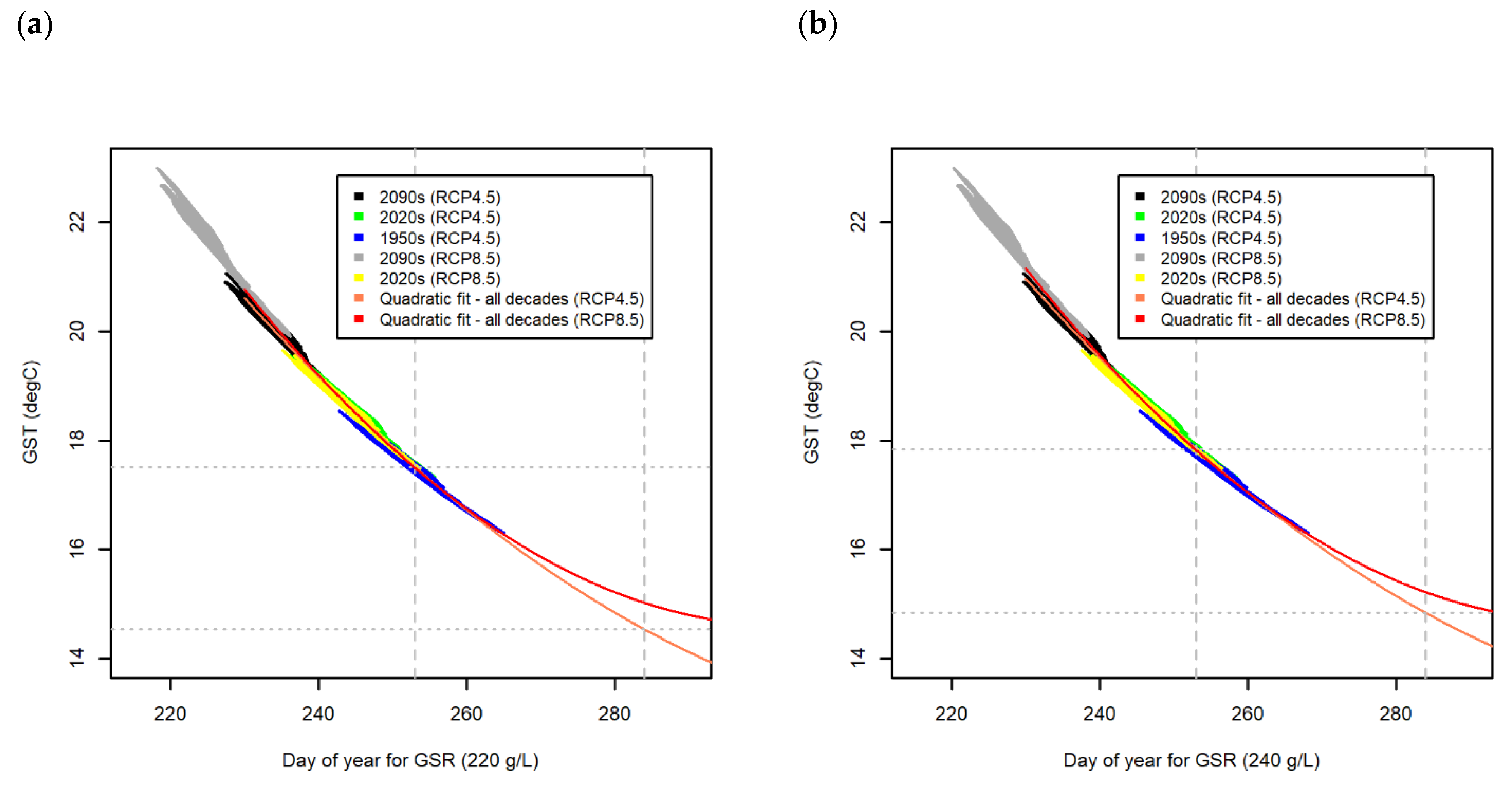
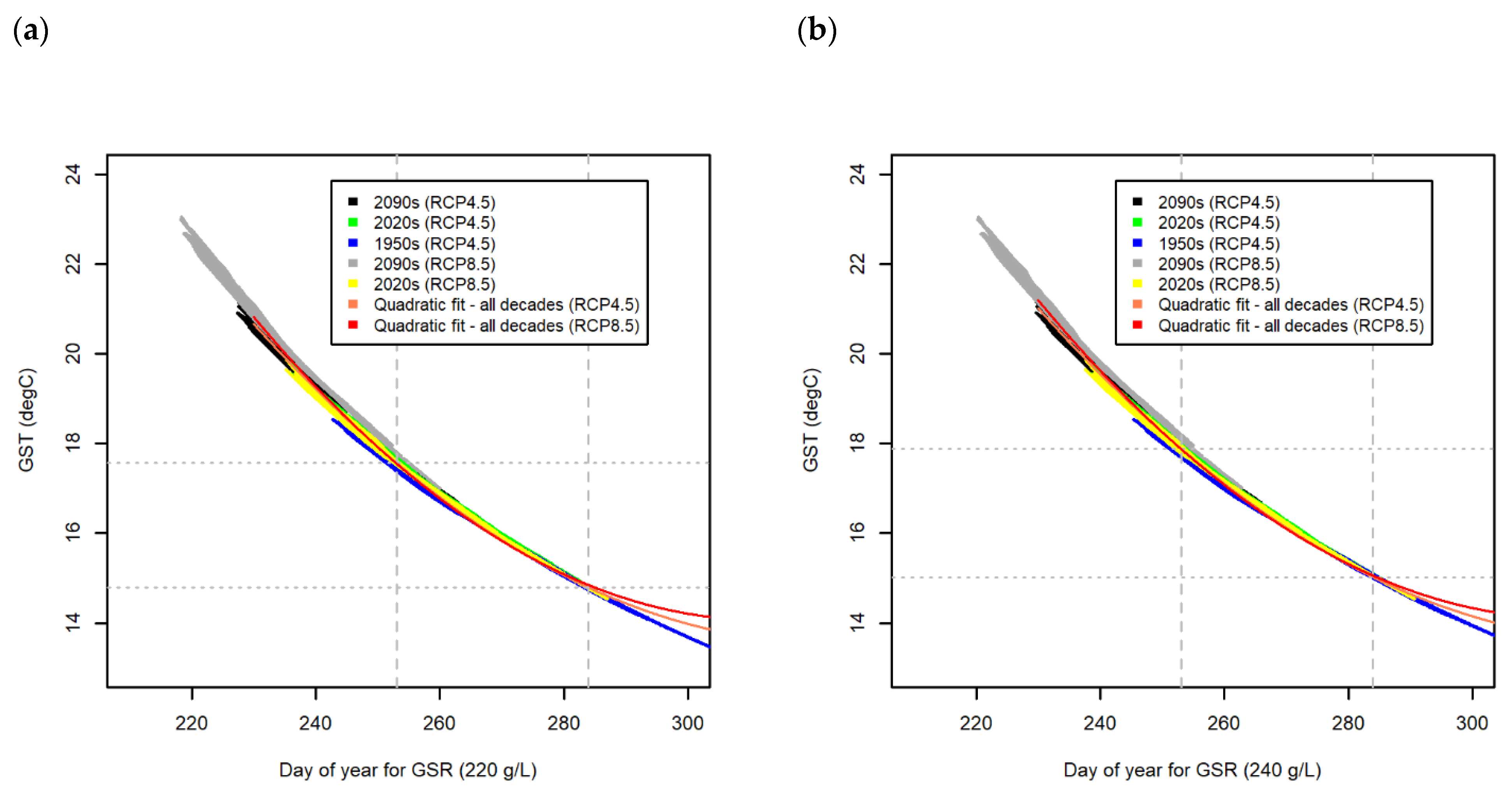
| GST | |
|---|---|
| Class Interval (°C) | Class of Viticulture Climate |
| <13 | Too cool |
| 13–15 | Cool |
| 15–17 | Intermediate |
| 17–19 | Warm |
| 19–21 | Hot |
| 21–24 | Very hot |
| >24 | Too hot |
| Target Sugar Concentration g/L | Value for Pinot Noir | Potential Alcohol (%) | ||
|---|---|---|---|---|
| Lower Bound (18) | European Conversion Ratio (16.83) | Upper Bound (16.5) | ||
| 170 | 2695 | 9.4 | 10.1 | 10.3 |
| 180 | 2734 | 10.0 | 10.7 | 10.9 |
| 190 | 2788 | 10.6 | 11.3 | 11.5 |
| 200 | 2838 | 11.1 | 11.9 | 12.1 |
| 210 | 2899 | 11.7 | 12.5 | 12.7 |
| 220 | 2933 | 12.2 | 13.1 | 13.3 |
| GST Index (°C) (RCP4.5) | |||||||||||||||
| 1950s | 1960s | 1970s | 1980s | 1990s | 2000s | 2010s | 2020s | 2030s | 2040s | 2050s | 2060s | 2070s | 2080s | 2090s | |
| Fort Ross-Seaview AVA | |||||||||||||||
| Min. | 14.8 | 14.8 | 15.0 | 15.1 | 15.2 | 15.4 | 15.6 | 15.8 | 16.0 | 16.2 | 16.4 | 16.4 | 16.6 | 16.8 | 16.9 |
| 1st Qu. | 16.0 | 16.1 | 16.3 | 16.3 | 16.4 | 16.6 | 16.8 | 17.1 | 17.3 | 17.4 | 17.7 | 17.6 | 17.9 | 18.0 | 18.1 |
| 2nd Qu. | 16.4 | 16.4 | 16.6 | 16.7 | 16.8 | 17.0 | 17.1 | 17.4 | 17.6 | 17.7 | 18.0 | 18.0 | 18.2 | 18.4 | 18.5 |
| 3rd Qu. | 16.7 | 16.7 | 16.9 | 17.0 | 17.1 | 17.3 | 17.4 | 17.7 | 17.9 | 18.1 | 18.4 | 18.3 | 18.5 | 18.7 | 18.8 |
| Max. | 17.3 | 17.3 | 17.5 | 17.6 | 17.7 | 17.9 | 18.1 | 18.4 | 18.6 | 18.7 | 19.0 | 18.9 | 19.1 | 19.3 | 19.4 |
| Los Carneros AVA | |||||||||||||||
| Min. | 17.2 | 17.2 | 17.4 | 17.5 | 17.7 | 17.9 | 17.9 | 18.2 | 18.5 | 18.7 | 19.1 | 18.9 | 19.2 | 19.4 | 19.6 |
| 1st Qu. | 17.6 | 17.6 | 17.8 | 18.0 | 18.1 | 18.3 | 18.3 | 18.6 | 18.9 | 19.1 | 19.5 | 19.3 | 19.6 | 19.8 | 20.0 |
| 2nd Qu. | 17.9 | 17.9 | 18.1 | 18.2 | 18.4 | 18.5 | 18.6 | 18.9 | 19.2 | 19.4 | 19.7 | 19.6 | 19.9 | 20.1 | 20.3 |
| 3rd Qu. | 18.0 | 18.0 | 18.3 | 18.4 | 18.5 | 18.7 | 18.7 | 19.0 | 19.3 | 19.5 | 19.9 | 19.7 | 20.0 | 20.3 | 20.4 |
| Max. | 18.8 | 18.8 | 19.0 | 19.1 | 19.2 | 19.4 | 19.5 | 19.8 | 20.0 | 20.2 | 20.6 | 20.5 | 20.7 | 21.0 | 21.1 |
| Petaluma Gap AVA | |||||||||||||||
| Min. | 13.4 | 13.4 | 13.6 | 13.7 | 13.8 | 13.9 | 14.1 | 14.4 | 14.6 | 14.7 | 15.0 | 15.0 | 15.2 | 15.4 | 15.5 |
| 1st Qu. | 16.2 | 16.2 | 16.4 | 16.5 | 16.7 | 16.8 | 16.9 | 17.2 | 17.4 | 17.6 | 18.0 | 17.9 | 18.1 | 18.3 | 18.5 |
| 2nd Qu. | 16.9 | 16.9 | 17.1 | 17.2 | 17.3 | 17.5 | 17.5 | 17.8 | 18.1 | 18.3 | 18.6 | 18.5 | 18.8 | 19.0 | 19.2 |
| 3rd Qu. | 17.3 | 17.3 | 17.5 | 17.6 | 17.8 | 17.9 | 18.0 | 18.3 | 18.6 | 18.7 | 19.1 | 19.0 | 19.2 | 19.5 | 19.6 |
| Max. | 18.1 | 18.1 | 18.3 | 18.4 | 18.5 | 18.7 | 18.8 | 19.1 | 19.3 | 19.5 | 19.9 | 19.8 | 20.0 | 20.3 | 20.4 |
| Russian River Valley AVA | |||||||||||||||
| Min. | 16.3 | 16.3 | 16.5 | 16.6 | 16.7 | 16.9 | 17.0 | 17.3 | 17.5 | 17.7 | 18.0 | 17.9 | 18.1 | 18.3 | 18.4 |
| 1st Qu. | 16.9 | 16.9 | 17.1 | 17.2 | 17.3 | 17.5 | 17.6 | 17.9 | 18.2 | 18.3 | 18.7 | 18.6 | 18.8 | 19.0 | 19.2 |
| 2nd Qu. | 17.1 | 17.1 | 17.3 | 17.5 | 17.6 | 17.8 | 17.8 | 18.1 | 18.4 | 18.5 | 18.9 | 18.8 | 19.0 | 19.3 | 19.4 |
| 3rd Qu. | 17.5 | 17.5 | 17.8 | 17.9 | 18.0 | 18.2 | 18.2 | 18.5 | 18.8 | 18.9 | 19.4 | 19.2 | 19.5 | 19.7 | 19.9 |
| Max. | 18.5 | 18.6 | 18.8 | 18.9 | 19.0 | 19.3 | 19.2 | 19.6 | 19.8 | 20.0 | 20.5 | 20.3 | 20.6 | 20.9 | 21.0 |
| All four AVAs Combined | |||||||||||||||
| Min. | 13.4 | 13.4 | 13.6 | 13.7 | 13.8 | 13.9 | 14.1 | 14.4 | 14.6 | 14.7 | 15.0 | 15.0 | 15.2 | 15.4 | 15.5 |
| 1st Qu. | 16.6 | 16.7 | 16.8 | 16.9 | 17.1 | 17.2 | 17.3 | 17.6 | 17.9 | 18.0 | 18.4 | 18.3 | 18.5 | 18.7 | 18.8 |
| 2nd Qu. | 17.0 | 17.1 | 17.3 | 17.4 | 17.5 | 17.7 | 17.7 | 18.0 | 18.3 | 18.5 | 18.8 | 18.7 | 19.0 | 19.2 | 19.3 |
| 3rd Qu. | 17.4 | 17.5 | 17.7 | 17.8 | 17.9 | 18.1 | 18.1 | 18.4 | 18.7 | 18.9 | 19.3 | 19.1 | 19.4 | 19.6 | 19.8 |
| Max. | 18.8 | 18.8 | 19.0 | 19.1 | 19.2 | 19.4 | 19.5 | 19.8 | 20.0 | 20.2 | 20.6 | 20.5 | 20.7 | 21.0 | 21.1 |
| GST Index (°C) (RCP8.5) | |||||||||||||||
| 1950s | 1960s | 1970s | 1980s | 1990s | 2000s | 2010s | 2020s | 2030s | 2040s | 2050s | 2060s | 2070s | 2080s | 2090s | |
| Fort Ross-Seaview AVA | |||||||||||||||
| Min. | 14.8 | 14.8 | 15.0 | 15.1 | 15.2 | 15.4 | 15.8 | 16.0 | 16.3 | 16.5 | 16.9 | 17.2 | 17.6 | 18.0 | 18.3 |
| 1st Qu. | 16.0 | 16.1 | 16.3 | 16.3 | 16.4 | 16.7 | 17.0 | 17.2 | 17.5 | 17.8 | 18.1 | 18.5 | 18.9 | 19.3 | 19.6 |
| 2nd Qu. | 16.4 | 16.4 | 16.6 | 16.7 | 16.8 | 17.0 | 17.4 | 17.6 | 17.9 | 18.1 | 18.5 | 18.8 | 19.3 | 19.7 | 20.0 |
| 3rd Qu. | 16.7 | 16.7 | 16.9 | 17.0 | 17.1 | 17.3 | 17.7 | 17.9 | 18.2 | 18.4 | 18.8 | 19.1 | 19.6 | 20.0 | 20.3 |
| Max. | 17.3 | 17.3 | 17.5 | 17.6 | 17.7 | 18.0 | 18.3 | 18.5 | 18.8 | 19.1 | 19.4 | 19.8 | 20.2 | 20.6 | 20.9 |
| Los Carneros AVA | |||||||||||||||
| Min. | 17.2 | 17.2 | 17.4 | 17.5 | 17.7 | 17.8 | 18.1 | 18.3 | 18.7 | 19.0 | 19.4 | 19.8 | 20.4 | 20.9 | 21.4 |
| 1st Qu. | 17.6 | 17.6 | 17.8 | 18.0 | 18.1 | 18.3 | 18.5 | 18.7 | 19.1 | 19.4 | 19.9 | 20.2 | 20.9 | 21.3 | 21.8 |
| 2nd Qu. | 17.9 | 17.9 | 18.1 | 18.2 | 18.4 | 18.5 | 18.7 | 19.0 | 19.4 | 19.7 | 20.1 | 20.5 | 21.1 | 21.5 | 22.1 |
| 3rd Qu. | 18.0 | 18.0 | 18.3 | 18.4 | 18.5 | 18.7 | 18.9 | 19.1 | 19.5 | 19.8 | 20.3 | 20.6 | 21.3 | 21.7 | 22.2 |
| Max. | 18.8 | 18.8 | 19.0 | 19.1 | 19.2 | 19.4 | 19.6 | 19.9 | 20.3 | 20.5 | 21.0 | 21.4 | 22.0 | 22.4 | 23.0 |
| Petaluma Gap AVA | |||||||||||||||
| Min. | 13.4 | 13.4 | 13.6 | 13.7 | 13.8 | 14.0 | 14.3 | 14.5 | 14.8 | 15.1 | 15.4 | 15.8 | 16.3 | 16.7 | 17.0 |
| 1st Qu. | 16.2 | 16.2 | 16.4 | 16.5 | 16.7 | 16.8 | 17.1 | 17.3 | 17.6 | 17.9 | 18.3 | 18.7 | 19.3 | 19.7 | 20.1 |
| 2nd Qu. | 16.9 | 16.9 | 17.1 | 17.2 | 17.3 | 17.5 | 17.7 | 18.0 | 18.3 | 18.6 | 19.0 | 19.4 | 20.0 | 20.4 | 20.9 |
| 3rd Qu. | 17.3 | 17.3 | 17.5 | 17.6 | 17.8 | 17.9 | 18.2 | 18.4 | 18.8 | 19.0 | 19.5 | 19.9 | 20.5 | 20.9 | 21.4 |
| Max. | 18.1 | 18.1 | 18.3 | 18.4 | 18.5 | 18.7 | 18.9 | 19.2 | 19.5 | 19.8 | 20.3 | 20.6 | 21.2 | 21.7 | 22.2 |
| Russian River Valley AVA | |||||||||||||||
| Min. | 16.3 | 16.3 | 16.5 | 16.6 | 16.7 | 16.9 | 17.3 | 17.5 | 17.8 | 18.0 | 18.4 | 18.8 | 19.2 | 19.6 | 19.9 |
| 1st Qu. | 16.9 | 16.9 | 17.1 | 17.2 | 17.3 | 17.5 | 17.8 | 18.0 | 18.4 | 18.7 | 19.1 | 19.4 | 20.0 | 20.4 | 20.8 |
| 2nd Qu. | 17.1 | 17.1 | 17.3 | 17.5 | 17.6 | 17.8 | 18.0 | 18.2 | 18.6 | 18.9 | 19.3 | 19.7 | 20.3 | 20.7 | 21.1 |
| 3rd Qu. | 17.5 | 17.5 | 17.8 | 17.9 | 18.0 | 18.1 | 18.3 | 18.6 | 19.0 | 19.2 | 19.7 | 20.1 | 20.8 | 21.1 | 21.7 |
| Max. | 18.5 | 18.6 | 18.8 | 18.9 | 19.0 | 19.2 | 19.4 | 19.6 | 20.0 | 20.3 | 20.8 | 21.2 | 22.0 | 22.3 | 23.0 |
| All four AVAs Combined | |||||||||||||||
| Min. | 13.4 | 13.4 | 13.6 | 13.7 | 13.8 | 14.0 | 14.3 | 14.5 | 14.8 | 15.1 | 15.4 | 15.8 | 16.3 | 16.7 | 17.0 |
| 1st Qu. | 16.6 | 16.7 | 16.8 | 16.9 | 17.1 | 17.3 | 17.5 | 17.8 | 18.1 | 18.4 | 18.7 | 19.1 | 19.6 | 20.0 | 20.4 |
| 2nd Qu. | 17.0 | 17.1 | 17.3 | 17.4 | 17.5 | 17.7 | 17.9 | 18.2 | 18.5 | 18.8 | 19.2 | 19.6 | 20.2 | 20.6 | 21.0 |
| 3rd Qu. | 17.4 | 17.5 | 17.7 | 17.8 | 17.9 | 18.1 | 18.3 | 18.5 | 18.9 | 19.2 | 19.6 | 20.0 | 20.6 | 21.1 | 21.6 |
| Max. | 18.8 | 18.8 | 19.0 | 19.1 | 19.2 | 19.4 | 19.6 | 19.9 | 20.3 | 20.5 | 21.0 | 21.4 | 22.0 | 22.4 | 23.0 |
| GSR (240 g/L): Pinot noir (Day of year from 1 January) (RCP4.5) | |||||||||||||||
| 1950s | 1960s | 1970s | 1980s | 1990s | 2000s | 2010s | 2020s | 2030s | 2040s | 2050s | 2060s | 2070s | 2080s | 2090s | |
| Fort Ross-Seaview AVA | |||||||||||||||
| Min. | 258 | 257 | 256 | 255 | 255 | 253 | 251 | 250 | 248 | 247 | 245 | 245 | 243 | 242 | 241 |
| 1st Qu. | 264 | 263 | 262 | 261 | 260 | 259 | 257 | 255 | 253 | 252 | 250 | 250 | 248 | 247 | 246 |
| 2nd Qu. | 267 | 266 | 265 | 264 | 263 | 262 | 260 | 258 | 256 | 254 | 252 | 253 | 251 | 250 | 248 |
| 3rd Qu. | 271 | 270 | 269 | 268 | 267 | 265 | 263 | 261 | 259 | 258 | 255 | 256 | 254 | 253 | 251 |
| Max. | 288 | 287 | 285 | 284 | 283 | 280 | 277 | 275 | 273 | 271 | 269 | 269 | 266 | 265 | 264 |
| Los Carneros AVA | |||||||||||||||
| Min. | 245 | 245 | 244 | 243 | 242 | 241 | 240 | 239 | 237 | 235 | 233 | 234 | 232 | 231 | 230 |
| 1st Qu. | 251 | 251 | 250 | 248 | 247 | 246 | 245 | 244 | 242 | 240 | 238 | 239 | 237 | 236 | 234 |
| 2nd Qu. | 252 | 252 | 251 | 250 | 249 | 248 | 247 | 245 | 243 | 241 | 239 | 240 | 238 | 237 | 235 |
| 3rd Qu. | 255 | 254 | 253 | 252 | 251 | 250 | 249 | 247 | 245 | 243 | 241 | 242 | 240 | 238 | 237 |
| Max. | 258 | 258 | 257 | 255 | 254 | 253 | 252 | 250 | 248 | 246 | 244 | 245 | 243 | 241 | 240 |
| Petaluma Gap AVA | |||||||||||||||
| Min. | 251 | 250 | 250 | 248 | 247 | 246 | 245 | 244 | 242 | 240 | 238 | 239 | 237 | 236 | 235 |
| 1st Qu. | 258 | 257 | 257 | 255 | 254 | 253 | 252 | 250 | 248 | 246 | 244 | 245 | 243 | 242 | 240 |
| 2nd Qu. | 262 | 261 | 261 | 259 | 258 | 257 | 256 | 254 | 252 | 250 | 248 | 248 | 246 | 245 | 243 |
| 3rd Qu. | 269 | 268 | 267 | 266 | 264 | 263 | 262 | 260 | 258 | 256 | 253 | 254 | 251 | 250 | 249 |
| Max. | 310 | 308 | 306 | 304 | 302 | 300 | 297 | 293 | 290 | 288 | 284 | 285 | 282 | 280 | 278 |
| Russian River Valley AVA | |||||||||||||||
| Min. | 245 | 245 | 244 | 243 | 242 | 241 | 240 | 239 | 237 | 235 | 233 | 234 | 232 | 231 | 230 |
| 1st Qu. | 256 | 255 | 254 | 253 | 252 | 250 | 250 | 248 | 246 | 244 | 242 | 243 | 240 | 239 | 238 |
| 2nd Qu. | 259 | 259 | 258 | 256 | 255 | 254 | 253 | 251 | 249 | 247 | 245 | 246 | 243 | 242 | 241 |
| 3rd Qu. | 261 | 260 | 260 | 258 | 257 | 256 | 254 | 253 | 251 | 249 | 247 | 247 | 245 | 244 | 243 |
| Max. | 268 | 267 | 266 | 265 | 264 | 262 | 260 | 259 | 257 | 255 | 253 | 253 | 251 | 250 | 249 |
| All four AVAs Combined | |||||||||||||||
| Min. | 245 | 245 | 244 | 243 | 242 | 241 | 240 | 239 | 237 | 235 | 233 | 234 | 232 | 231 | 230 |
| 1st Qu. | 256 | 256 | 255 | 254 | 253 | 251 | 250 | 249 | 247 | 245 | 243 | 243 | 241 | 240 | 239 |
| 2nd Qu. | 260 | 259 | 259 | 257 | 256 | 255 | 254 | 252 | 250 | 248 | 246 | 246 | 244 | 243 | 242 |
| 3rd Qu. | 264 | 264 | 263 | 261 | 260 | 259 | 257 | 256 | 254 | 252 | 249 | 250 | 248 | 247 | 245 |
| Max. | 310 | 308 | 306 | 304 | 302 | 300 | 297 | 293 | 290 | 288 | 284 | 285 | 282 | 280 | 278 |
| GSR (240 g/L): Pinot noir (Day of year from 1 January) (RCP8.5) | |||||||||||||||
| 1950s | 1960s | 1970s | 1980s | 1990s | 2000s | 2010s | 2020s | 2030s | 2040s | 2050s | 2060s | 2070s | 2080s | 2090s | |
| Fort Ross-Seaview AVA | |||||||||||||||
| Min. | 258 | 257 | 256 | 255 | 255 | 253 | 249 | 248 | 246 | 244 | 242 | 240 | 237 | 234 | 232 |
| 1st Qu. | 264 | 263 | 262 | 261 | 260 | 258 | 255 | 253 | 251 | 249 | 246 | 244 | 241 | 238 | 236 |
| 2nd Qu. | 267 | 266 | 265 | 264 | 263 | 261 | 258 | 256 | 253 | 252 | 249 | 246 | 243 | 240 | 238 |
| 3rd Qu. | 271 | 270 | 269 | 268 | 267 | 265 | 261 | 259 | 256 | 255 | 252 | 249 | 246 | 243 | 241 |
| Max. | 288 | 287 | 285 | 284 | 283 | 280 | 275 | 272 | 270 | 267 | 264 | 261 | 257 | 253 | 252 |
| Los Carneros AVA | |||||||||||||||
| Min. | 245 | 245 | 244 | 243 | 242 | 241 | 239 | 238 | 235 | 234 | 231 | 228 | 225 | 223 | 220 |
| 1st Qu. | 251 | 251 | 250 | 248 | 247 | 247 | 245 | 243 | 240 | 239 | 236 | 233 | 230 | 227 | 225 |
| 2nd Qu. | 252 | 252 | 251 | 250 | 249 | 248 | 246 | 244 | 241 | 240 | 236 | 234 | 231 | 228 | 225 |
| 3rd Qu. | 255 | 254 | 253 | 252 | 251 | 250 | 248 | 246 | 243 | 241 | 238 | 236 | 232 | 229 | 227 |
| Max. | 258 | 258 | 257 | 255 | 254 | 253 | 251 | 249 | 246 | 244 | 241 | 239 | 235 | 232 | 229 |
| Petaluma Gap AVA | |||||||||||||||
| Min. | 251 | 250 | 250 | 248 | 247 | 246 | 245 | 243 | 240 | 239 | 236 | 233 | 230 | 227 | 225 |
| 1st Qu. | 258 | 257 | 257 | 255 | 254 | 253 | 251 | 249 | 246 | 245 | 241 | 239 | 235 | 232 | 230 |
| 2nd Qu. | 262 | 261 | 261 | 259 | 258 | 257 | 255 | 252 | 250 | 248 | 245 | 242 | 239 | 235 | 233 |
| 3rd Qu. | 269 | 268 | 267 | 266 | 264 | 263 | 260 | 258 | 255 | 254 | 250 | 247 | 243 | 240 | 237 |
| Max. | 310 | 308 | 306 | 304 | 302 | 299 | 294 | 291 | 287 | 284 | 279 | 275 | 270 | 266 | 263 |
| Russian River Valley AVA | |||||||||||||||
| Min. | 245 | 245 | 244 | 243 | 242 | 241 | 239 | 238 | 235 | 234 | 231 | 229 | 226 | 223 | 220 |
| 1st Qu. | 256 | 255 | 254 | 253 | 252 | 251 | 249 | 247 | 244 | 242 | 239 | 236 | 233 | 230 | 227 |
| 2nd Qu. | 259 | 259 | 258 | 256 | 255 | 254 | 252 | 250 | 247 | 245 | 242 | 239 | 236 | 233 | 231 |
| 3rd Qu. | 261 | 260 | 260 | 258 | 257 | 256 | 253 | 251 | 248 | 247 | 244 | 241 | 238 | 235 | 232 |
| Max. | 268 | 267 | 266 | 265 | 264 | 262 | 259 | 257 | 254 | 252 | 249 | 246 | 243 | 240 | 239 |
| All four AVAs Combined | |||||||||||||||
| Min. | 245 | 245 | 244 | 243 | 242 | 241 | 239 | 238 | 235 | 234 | 231 | 228 | 225 | 223 | 220 |
| 1st Qu. | 256 | 256 | 255 | 254 | 253 | 251 | 250 | 247 | 245 | 243 | 240 | 237 | 234 | 231 | 228 |
| 2nd Qu. | 260 | 259 | 259 | 257 | 256 | 255 | 252 | 250 | 248 | 246 | 243 | 240 | 237 | 234 | 231 |
| 3rd Qu. | 264 | 264 | 263 | 261 | 260 | 259 | 256 | 254 | 251 | 250 | 246 | 244 | 240 | 237 | 235 |
| Max. | 310 | 308 | 306 | 304 | 302 | 299 | 294 | 291 | 287 | 284 | 279 | 275 | 270 | 266 | 263 |
| AVA | Observations | GSR (240 g/L): RCP4.5/RCP8.5 | ||||
|---|---|---|---|---|---|---|
| Harvest Date | % Alcohol | Mean | Median | Minimum | Maximum | |
| Fort Ross-Seaview | 262.5 | 13.7 | 260/258 | 260/258 | 251/249 | 277/275 |
| Los Carneros | 250 | 14.5 | 247/246 | 247/246 | 240/239 | 252/251 |
| Petaluma Gap | 259 | 14.0 | 258/257 | 256/255 | 245/245 | 297/294 |
| Russian River Valley | 255 | 14.3 | 252/251 | 253/252 | 240/239 | 260/259 |
Disclaimer/Publisher’s Note: The statements, opinions and data contained in all publications are solely those of the individual author(s) and contributor(s) and not of MDPI and/or the editor(s). MDPI and/or the editor(s) disclaim responsibility for any injury to people or property resulting from any ideas, methods, instructions or products referred to in the content. |
© 2023 by the authors. Licensee MDPI, Basel, Switzerland. This article is an open access article distributed under the terms and conditions of the Creative Commons Attribution (CC BY) license (https://creativecommons.org/licenses/by/4.0/).
Share and Cite
Skahill, B.; Berenguer, B.; Stoll, M. Climate Projections for Pinot Noir Ripening Potential in the Fort Ross-Seaview, Los Carneros, Petaluma Gap, and Russian River Valley American Viticultural Areas. Agronomy 2023, 13, 696. https://doi.org/10.3390/agronomy13030696
Skahill B, Berenguer B, Stoll M. Climate Projections for Pinot Noir Ripening Potential in the Fort Ross-Seaview, Los Carneros, Petaluma Gap, and Russian River Valley American Viticultural Areas. Agronomy. 2023; 13(3):696. https://doi.org/10.3390/agronomy13030696
Chicago/Turabian StyleSkahill, Brian, Bryan Berenguer, and Manfred Stoll. 2023. "Climate Projections for Pinot Noir Ripening Potential in the Fort Ross-Seaview, Los Carneros, Petaluma Gap, and Russian River Valley American Viticultural Areas" Agronomy 13, no. 3: 696. https://doi.org/10.3390/agronomy13030696
APA StyleSkahill, B., Berenguer, B., & Stoll, M. (2023). Climate Projections for Pinot Noir Ripening Potential in the Fort Ross-Seaview, Los Carneros, Petaluma Gap, and Russian River Valley American Viticultural Areas. Agronomy, 13(3), 696. https://doi.org/10.3390/agronomy13030696





